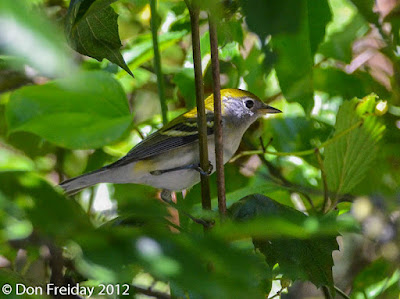[This Spicebush Swallowtail was "puddling" in the mud underneath my water spigot on Wednesday evening, seeking nutrients and salts rather than nectar.]
Barring rare strays, we've got three dark-colored swallow-tailed butterflies to identify in NJ. I usually slide through identifying them by habitat and flight style, without really looking close:
- If it's small and out in the open, and flying fast, it's a Black Swallowtail.
- If it's medium sized and in the woods, or in a meadow near the woods, and flying moderately fast, it's a Spicebush Swallowtail.
- If it's large, in a meadow or woods, and flying slow and languidly, often sailing, it's the dark form of a Tiger Swallowtail (all dark Tigers are females).
One of these days someone will refine this stuff into a "Butterflies in Flight" field guide, kind of like how we tell Sharp-shinned Hawks from Cooper's Hawks. In the meantime, the dark swallowtails also have easy and obvious "plumage" differences - I mean color differences. Someday we'll look at differences in the upperwings of the three species, but since all we have here is the underwing, let's look at that.
I.D. of the pictured Spicebush Swallowtail is somewhat confounded by the fact that something has bitten the back of its hindwing off, but we can note that while the rear underwing band of orange spots has been eaten, the remaining forward orange underwing band of spots is obvious but missing one orange dot, replaced by a greenish blue one. On a Black Swallowtail the two orange bands on the underside of the hindwing are complete, and there's an extra spot in front of the forward orange band. Dark female Tiger Swallowtails have only a single orange spot-band (and lack the yellow-spotted body).
On a completely different i.d. subject, it was Janet Crawford (formerly with the FBI) who I first heard use the term "street cred" in a birding context. That was after I reported some rare bird or other that no one else saw and I did not photograph, and she allowed I had enough streed cred (i.e. credibility) that it would be believed.
So I leaned on the street cred pretty hard on last Monday when I found and reported a Townsend's Warbler at Forsythe NWR, a bird I identified instantly and then studied for a few seconds to confirm, as it turns out using all the seconds I would get to look at it. Thus I never managed a picture. Given that this is the 11th state record and out of pattern for the species (most have been late fall/winter), I almost said nothing about it to anyone. But it was not a difficult i.d. My notes accompanying the report to eBird were: "Ad female or first fall male, strong dark cheek, yellow comma under eye, heavily streaked throat and flanks but not solid black to chin, yellow breast extending to rear flanks. Obvious wing bars. Fed with mixed sp flock, mid to upper canopy mostly in interior of trees. No photo could be obtained. Wow."


No comments:
Post a Comment